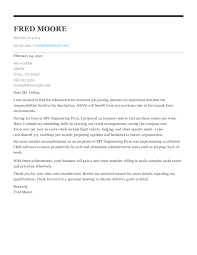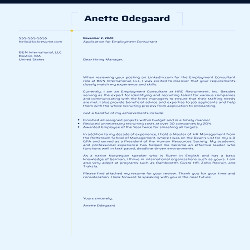
Unlock Success with These Stellar Cover Letter Examples: Your Key to Landing the Dream Job!
Cover letter examples are pre-written templates that provide a guideline for job seekers on how to effectively communicate their skills, experiences, and suitability for a job. They provide a structured format for presenting personal qualities and professional competencies in a concise and compelling manner, helping to create a strong first impression on potential employers. They are tailored to various industries and job roles, offering a helpful guide for crafting a unique and powerful cover letter.
| Contact Information | Your name, address, phone number, email address. |
| Date | The day you're sending the cover letter. |
| Employer's Contact Information | Name, title, company, address. |
| Salutation | Addressing the hiring manager by their proper title. |
| Introduction | Short paragraph introducing yourself and explaining why you're applying. |
| Body | 1-2 paragraphs discussing your skills, experiences and what you can bring to the company. |
| Closing | Short paragraph summarizing the above points, expressing enthusiasm for the role and requesting an interview. |
| Sign off | Professional sign off, such as "Sincerely" or "Best regards," followed by your name. |
| Enclosure | Indication that your resume is included with the cover letter. |
| Postscript (Optional) | A final, compelling reason why you would be a good fit for the role. |
Customization is Key
A vital aspect of a compelling cover letter is customization. This means tailoring your cover letter to the job description and the company's needs. Use industry-related terms to enhance your credibility and show your knowledge of the field. Read more
Addressing the Right Person
Whenever possible, address your cover letter to a specific individual. This personal touch shows that you've done your research and are serious about your application. It also helps your cover letter stand out in a sea of generic applications. Read more
Highlighting Relevant Skills
Your cover letter is an opportunity to showcase your most relevant skills. Be sure to highlight how your skills specifically align with the job requirements. Use concrete examples to demonstrate your expertise in action. Read more
Showing Enthusiasm
Employers want to hire people who are enthusiastic about their work. In your cover letter, express your excitement about the job and the company. This can make you more appealing to an employer and increase your chances of landing an interview. Read more

Professional Tone
Keep the tone of your cover letter professional. Avoid using slang or informal language. Your cover letter is a reflection of your professionalism, so make sure it represents you well. Read more
Perfecting Your Grammar and Spelling
A cover letter with grammar and spelling errors can harm your chances of getting an interview. Double-check your work for errors or have someone else review it to ensure it's error-free. Read more
Keeping it Concise
Your cover letter should be concise and to the point. Aim for no more than one page. This shows that you value the employer's time and can communicate effectively. Read more
Strong Closing
End your cover letter on a strong note. Reiterate your interest in the position and your confidence in your ability to perform well. A strong closing can leave a lasting impression on the employer. Read more

Follow-Up
Mention in your cover letter that you plan to follow up on your application. This shows initiative and can help keep your application top of mind for the employer. Read more
Quality Presentation
Finally, remember that presentation matters. Use a clean, professional font and layout for your cover letter. This can help your application look more professional and appealing to the employer. Read more
Facts
1. The Birth of the Brand:The brand we are talking about is none other than Apple Inc., a technological giant that has revolutionized the world with its innovative gadgets and software. Founded by Steve Jobs, Steve Wozniak, and Ronald Wayne, Apple has its roots in a garage where the trio started their journey in 1976.
2. Revolutionizing Communication:
Apple’s first ever product was the Apple I, a personal computer kit. But it was the introduction of the iPhone in 2007 that changed the way we communicate forever. It was the first phone with a touch interface and no physical keyboard, making it a game changer in the industry.
3. The Iconic Logo:
Apple’s logo, the bitten apple, is recognized worldwide. However, the initial logo was a detailed drawing of Sir Isaac Newton sitting under an apple tree. The simpler and more iconic logo we know today was introduced in 1977.
4. A Tribute to The Beatles:
One of the most interesting facts is that the name 'Apple' was chosen as a tribute to The Beatles' record label, Apple Corps. However, this led to a series of legal battles between the two companies over trademark rights.
5. The Power of Macintosh:
The Macintosh, introduced in 1984, was the first mass-market personal computer featuring a graphical user interface (GUI) and a mouse. This breakthrough product set the standards for future personal computers.
6. A Step into the Music Industry:
In 2001, Apple stepped into the music industry with the launch of iPod and the iTunes music store. This move revolutionized the music industry by offering digital downloads, ultimately leading to the decline of physical CDs.
7. The Magic of Siri:
With the introduction of Siri in 2011, Apple changed the way we interact with our devices. This voice-controlled personal assistant is capable of performing various tasks, from setting alarms to providing weather updates and answering trivia questions.
8. Apple’s Journey to Trillion:
In August 2018, Apple became the first U.S. company to reach a market cap of $1 trillion. This milestone demonstrates the company’s growth and dominance in the tech industry.
9. The Eco-Friendly Approach:
Apple is committed to reducing its environmental impact. The company is aiming to become completely carbon neutral by 2030. They are also known for their recycling program where they encourage users to recycle old devices.
10. The Secretive Culture:
Apple is known for its secretive culture. From the famous no leaks policy to the mysterious Area 51 of its Cupertino campus, the company goes to great lengths to keep its projects and products under wraps until they are ready for launch.
Read more
![21+ Cover Letter Examples in 2023 [For All Professions]](/static/cover letter examples/1.thumb.png) 21+ Cover Letter Examples in 2023 [For All Professions]
21+ Cover Letter Examples in 2023 [For All Professions]![21+ Cover Letter Examples in 2023 [For All Professions]](/static/cover letter examples/2.thumb.jpeg) 21+ Cover Letter Examples in 2023 [For All Professions]
21+ Cover Letter Examples in 2023 [For All Professions]![21+ Cover Letter Examples in 2023 [For All Professions]](/static/cover letter examples/3.thumb.jpeg) 21+ Cover Letter Examples in 2023 [For All Professions]
21+ Cover Letter Examples in 2023 [For All Professions] Cover Letter Examples for Job Seekers in 2023
Cover Letter Examples for Job Seekers in 2023![21+ Cover Letter Examples in 2023 [For All Professions]](/static/cover letter examples/5.thumb.jpeg) 21+ Cover Letter Examples in 2023 [For All Professions]
21+ Cover Letter Examples in 2023 [For All Professions] 240+ Cover Letter Examples to Get a Job in 2023 | LiveCareer
240+ Cover Letter Examples to Get a Job in 2023 | LiveCareer Cover Letter Examples and Writing Tips
Cover Letter Examples and Writing Tips 20+ Cover Letter Templates for a Resume in 2023 (Free)
20+ Cover Letter Templates for a Resume in 2023 (Free) 250+ Cover Letter Examples to Inspire You (Updated for 2023)
250+ Cover Letter Examples to Inspire You (Updated for 2023) Cover Letter Examples to Get a Job in 2023
Cover Letter Examples to Get a Job in 2023 52 Professional Cover Letter Examples For Job Seekers in 2023
52 Professional Cover Letter Examples For Job Seekers in 2023 20+ Cover Letter Templates for a Resume in 2023 (Free)
20+ Cover Letter Templates for a Resume in 2023 (Free)![21+ Cover Letter Examples in 2023 [For All Professions]](/static/cover letter examples/13.thumb.jpeg) 21+ Cover Letter Examples in 2023 [For All Professions]
21+ Cover Letter Examples in 2023 [For All Professions] Professional Cover Letter - Examples, PDF | Examples
Professional Cover Letter - Examples, PDF | Examples 240+ Cover Letter Examples to Get a Job in 2023 | LiveCareer
240+ Cover Letter Examples to Get a Job in 2023 | LiveCareer Finance Cover Letter Example & Writing Tips | Resume Genius
Finance Cover Letter Example & Writing Tips | Resume Genius Employment Consultant Cover Letter Sample | Kickresume
Employment Consultant Cover Letter Sample | Kickresume![21+ Cover Letter Examples in 2023 [For All Professions]](/static/cover letter examples/18.thumb.jpeg) 21+ Cover Letter Examples in 2023 [For All Professions]
21+ Cover Letter Examples in 2023 [For All Professions] Server Cover Letter Example | Resume Genius
Server Cover Letter Example | Resume Genius The 23 Best Cover Letter Examples: What They Got Right
The 23 Best Cover Letter Examples: What They Got Right